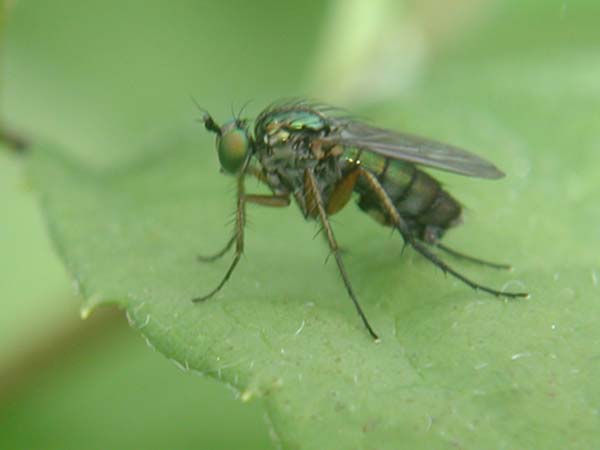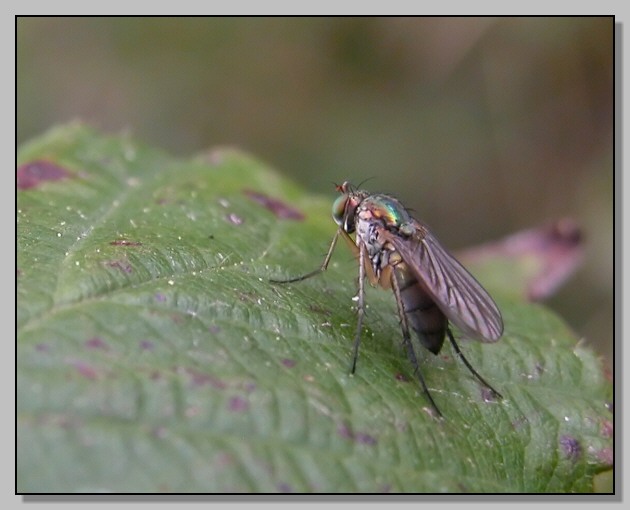Thread subject: Diptera.info :: Identification required
Posted by ChasMacey on 24-11-2005 23:18
#1
Hi,
I am trying to identify a number of insects that I came across in the garden this year, and could do with some assistance with a few of them. I think that the attached picture is of a Dolichopodid fly but would appreciate it if anyone could either confirm and be more specific or correct me on this. The picture was taken in Surrey (UK) at the beginning of June this year.
Regards Chas

Posted by Kahis on 25-11-2005 00:58
#3
It is
Dolichopus ungulatus, no question about that.B)
Posted by lynkos on 25-11-2005 09:05
#4
Don't know, but picture above reminded me greatly of this fly I photographed in Cornwall this summer. I didn't post it before as I wasn't happy with the photo, but now I'm curious. Is this Dolichopodidae too?

Thanks, Sarah
Posted by ChasMacey on 25-11-2005 11:40
#5
Thanks for that Paul and Kahis,
I also previously had checked images on the Bioimages sites which only showed Dolichopus popularis and Dolichopus pennatus which looked very similar, I have noted the description with the other posting that Paul suggested I check, so is there a way to distinguish between the other two ?
Regards Chas
Posted by Kahis on 25-11-2005 12:16
#6
Shape & body colour is quite constant among
Dolichopus. Fortunately there are many details especially on males that help in identification. The combination of black antenna, black postocular setae (along edge of compound eye, seen as a black line in the photo above) and two or more strong setae on hind femur is unique for
D. ungulatus.
D. pennatus has a similar set of characters: middle tarsus with outer four segments flattened. 2nd and 3rd segment black, 4th and 5th silvery. The leg structure can be seen on BioImages' photo of
pennatus:
http://www.bioima...P44314.HTM. There is only one other species with a similar middle leg,
D. subpennatus d'Assis-Fonseca 1976. These two species can't easily be identified from photographs.
D. argyrotarsis is somewhat similar but it has three silvery segments on middle tarsus.
Sarah: yeah, your photo is of a female
Dolichopus.
Edited by Kahis on 25-11-2005 12:17
Posted by Kahis on 25-11-2005 12:23
#7
Check the color of antenna: all black in ungulatus, narrowly orange below in pennatus and mostly yellow in popularis. There flies are easy to identify once you know what to look for.B) I'm building a 'detail library' for exactly this purpose. Only a few sample pics are on the net for now:
http://www.elisan...mages.html
Posted by lynkos on 25-11-2005 12:50
#8
Thanks Kahis. I'm coming to realise that although there are, of course, distinguishing characteristics for all the families and with time, patience and skill you can learn to tell them apart, there is a sort of "feel" to a lot of these families which it's quite hard to put into words but which kind of guides the intuition in the right direction! Don't feel if I've explained myself very clearly :(. Sarah
Posted by Jan Willem on 25-11-2005 13:37
#9
Well Sarah, I think you explained yourself quite clearly! I think it's just a matter of getting more experience with the complete habitus of the different families of Diptera. After a while you don't need to look at the characters used in the keys to know that a species belongs to a certain family.
Jan Willem
Posted by ChasMacey on 26-11-2005 23:07
#10
Thanks for the detailed explanation it's just what I was after, all I need to do now is remember it for next season.
Thanks again to all.
Chas

